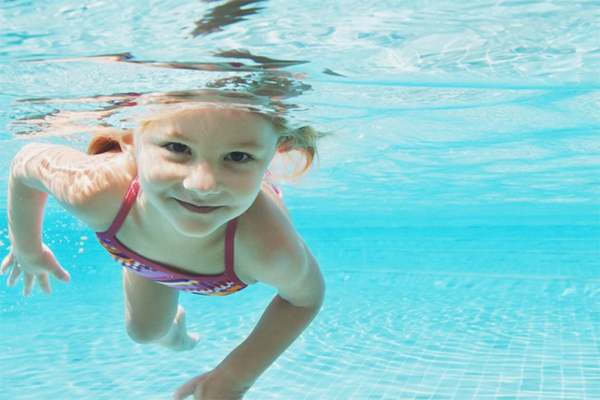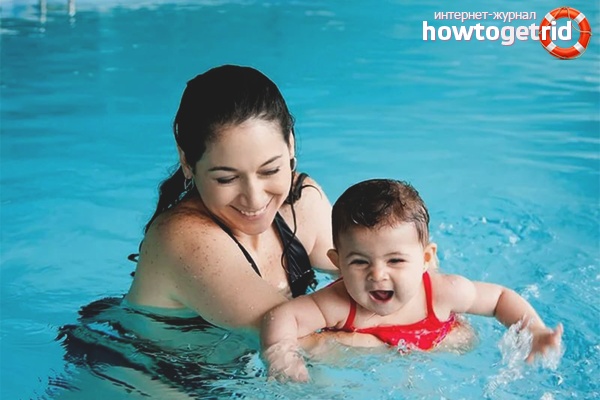The content of the article
Swimming is an incredibly useful physical activity that allows you to tighten and train your muscles, without giving the load on the ligaments and the spine. A child who can swim has good coordination, developed respiratory system, he is less likely to get sick. All parents are aware of the benefits of swimming, so they try to get the child accustomed to water as soon as possible. But how to make it as painless as possible? How to show a child that floating is easy, you just need to try. After all, the wrong skills develop in the child the habit of not moving in the right way. Subsequently, retraining a baby becomes very difficult, and the ability to swim is postponed indefinitely.
Extreme learning or why not throw a child into the water
Until recently, there was a “household” way of teaching a child to swim. The kids were simply thrown into the water and given the opportunity to “swim out” on their own. Proponents of this method say that survival is innate, and in many cases the child overcomes fear and begins to swim independently. However, this cannot be done in any way. First, the baby can not swim. Just get lost, scared and starts to sink. Of course, you will be near and save your child, but after that he will not come close to the water. Such an extreme learning will leave the child fear of water for life.
The second reason why a child should not be thrown into the water is to undermine trust. For a baby, parents are the rock that you can rely on at any time. The child trusts you unconditionally, how can you expose him dangerously on purpose? Many adults who have learned to swim in this way admit that they still harbor a grudge against their parents for such an act, even though he taught them to swim. After such actions, it will be difficult to regain the trust of the child.That is why it is worth teaching the child gradually and consistently.
When to learn to swim
Surely you have seen newborns who enjoy swimming in open water without the support of adults? This is not surprising, the water for babies of the first months of life is the native element, the baby remembers it from the mother's womb. Over time, these memories are erased, the baby loses skill and stops swimming on its own. When it is possible to accustom the baby to water again?
If your baby is not even a year old, try swimming in a bath with a special circle. It is worn on the neck and secured with a secure clasp. Thanks to this circle, the baby's head is always on the surface, he moves his legs and arms with ease and pleasure. Movement under the water is easier, so the kids love this kind of swimming. In addition, the mother does not have to constantly hold the head of the child while bathing. It is quite inconvenient to stand the letter "sic" for 10-15 minutes. Such swimming strengthens the baby's muscular corset, improves blood circulation in the tissues, and contributes to enhanced growth.
If your baby is more than a year old, it is too early for him to swim independently in the pool. Up to three years, you just need to encourage in every way the child’s desire for water, more often get out in the summer to the reservoirs, spend more time near the water. In this case, it is useful to play various games that will make the child feel more confident in the water.
- Sea battle. This game will teach the child to the fact that water can fall on the face and head, and there is nothing wrong with that. Go with the child into the water so that its depth is the maximum across the chest of your child. After that, start splashing at each other (give in to the child). The one who first says "give up" loses and turns away.
- Who is first? For the next game you will need an assistant, for example, dad. Conditions are - dad gets up in the water a few meters from the competitors. Whoever reaches the dad ahead of the water - he won. In this game it is important to teach the child to rake the water in front of him. Baby should understand how to move in the water. He realizes that if you help yourself with your hands, he will move much faster.
- Underwater world. You can also teach your child to open his eyes under water.To do this, sit down with the baby in the water and try to open your eyes. If you are at sea or in a lake, you can consider sand and plants. If in the pool - drawing on the bottom or toys in their hands. If it does not work out, try doing it with special glasses.
- Bubbles This exercise teaches a child to breathe properly underwater. Quickly inhale the air and slowly exhale it with your nose under water. Kids love to give out a large number of bubbles, so they especially like this exercise. You can not even immerse yourself in water, just put a face in a liquid.
These simple exercise games will help your little one not to be afraid of water, but to perceive it as a friendly element.
Where, with whom and how to learn to swim
Already by 3-4 years old child can learn to swim. By this time, the little ones already understand a lot, do the exercises and are able to adequately assess the situation. It is very important to determine where you will learn to swim. If it is an open reservoir, you need to be sure of its safety. On the shore and at the bottom should not be glasses and sharp objects, kryagi, pieces of reinforcement.The reservoir itself must be flowing - bacteria grow in stagnant water. It is very important that the water is not cold, the lower limit is 23 degrees. The weather should also be warm - the air temperature is at least 27 degrees. You should first investigate the bottom on which you are going to teach the child. It is important that there are no sharp and sharp downturns, undercurrents and other factors representing a potential danger. The water level in the designated place should not be higher than the baby’s chest.
In the pool for the child all the conditions. The main thing is not to go directly to the depth, but to train in the “paddling pool” so that the water level is on the chest. In addition, in the pool, you can hire a special swimming instructor who will tell you at a professional level how to teach a child to swim. Often, when the child is not even five years old, the instructor works in tandem with the parent. That is, the child can not engage with a stranger, so the instructor teaches the method of swimming parent, and he shows all the baby. Experienced coaches say that the kid learns to swim best with his mother, because women are more patient by nature and like the process.But men are focused on results and often push the child, which is unacceptable in matters of swimming training. But if the father is patient and assiduous - he may well become a swimming instructor for his child.
How to teach a child to swim
We will tell you about the basic exercises that will help you teach your child to float, hold his breath in time and paddle with his hands and feet.
In the training can not use sleeves, vests and other accessories that initially form a child's improper retention of the body in the water. Just look, in what unnatural position is the baby in arm ruffles in the water. It is very important to teach the child to take a horizontal position. This can be achieved only with a special board, which at first will support the baby. This is the only accessory that can be used in a difficult learning process. The board supports the child, as it were, but at the same time teaches him to coordinate movement, find balance, move limbs.
The child lays breast on the board, and mother simply pulls him by the arms.Thus, the baby is fixed in a horizontal position, knowing exactly how to move in the water.
- After that, you can complicate the exercise, asking the baby to actively move his legs. The child must understand that this gives the movement speed. But simple ploping is not enough, you need to move your limbs, like fins. In order for the child to feel it, you can let him move his legs in flippers.
- Stand in the water and ask the child to squat. The water level should first reach the chin, then to the nose, and then the body should be completely immersed in water. Here we are training the psychological aspect more - the child should feel confident that if necessary he can always emerge, he should not be afraid. If you cannot dive with your eyes open and your nose, you can close them. In addition, this exercise teaches the child to hold his breath at the moment when you are under water.
- After the baby begins to dive well and stop being afraid of it, ask him to stretch his arms forward. After another dive, drag a crumb under water for some distance.It may be at least half a meter, but the baby should feel the dynamics. At the end of this distance, push the crumb to the surface and say to him: “Inhale!”. The baby must develop a clear association — when we emerge, we breathe in air, and at the same time, you emerge for breath when we do not have enough air. It is important to convince the child that everything is under control, that he himself can control the situation.
- The next exercise is that you drag a child through the water, and at this time he himself emerges to inhale and sinks himself into the water. It is very important to follow the legs so that the baby does not walk along the bottom, but keeps them on the surface, that is, swimming. This is a long exercise, the development of which takes a lot of time, but you should not force things - show patience.
- When the skills are perfect and the child stops breathing heavily, try to let go of your hands, first one, and then both. If the baby is in the correct horizontal position, he will not go to the bottom, the water will push him out. You will only need to stand side by side, and secure the crumbs. If the baby succeeds in this exercise, consider that he has learned to swim.
- When the baby learns to dive and dive, tell the child how to dive independently. To do this, put your palms together and direct them towards the water. Then slowly sink into the water behind your hands and emerge as you did before.
- Acting by this method, you can teach a child not only to swim, but to swim correctly. Subsequently, from this skill, you can extract the literate and beautiful style of the butterfly, brass, crawl, and other areas.
Swimming is the best sport for a child’s body. This physical activity has virtually no contraindications, since the body does not experience serious stress. However, you need to be careful with water diving, if there is a violation of the eardrum, chronic otitis or sinusitis. Be healthy and enjoy the water element with your child!
Video: learn to swim baby












To send